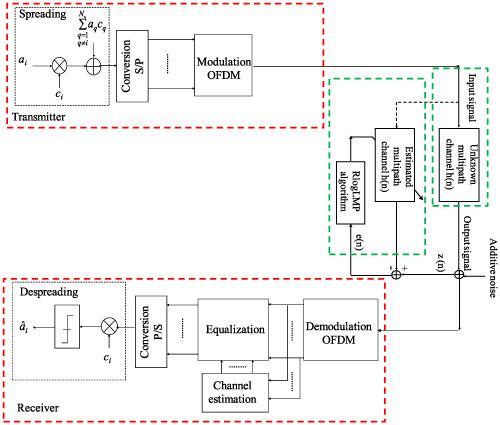当前位置:
X-MOL 学术
›
Int. J. Commun. Syst.
›
论文详情
Our official English website, www.x-mol.net, welcomes your
feedback! (Note: you will need to create a separate account there.)
A new combination of adaptive channel estimation methods and TORC equalizer in MC‐CDMA systems
International Journal of Communication Systems ( IF 1.7 ) Pub Date : 2020-04-20 , DOI: 10.1002/dac.4429 Mohammed Zidane 1 , Rui Dinis 2
International Journal of Communication Systems ( IF 1.7 ) Pub Date : 2020-04-20 , DOI: 10.1002/dac.4429 Mohammed Zidane 1 , Rui Dinis 2
Affiliation

|
Adaptive systems identification has been widely studied, but most studies have focused on the convergence of these methods. Applications of equalization systems have also received much attention. This paper presents a new combination of adaptive Broadband Radio Access Networks (BRAN) channel identification algorithms for multicarrier code division multiple access (MC‐CDMA) systems downlink equalization. In fifth‐generation (5G) wireless communications, MC‐CDMA is expected to support the associated networks. The BRAN E channel parameters, representing an outdoor scenario normalized for MC‐CDMA systems, are identified using a recursive least mean pth power algorithm with logarithmic transformation (RlogLMP). For validity and test aim, this algorithm is compared with the existing recursive least square (RLS) and least mean square (LMS) algorithms. Moreover, we use the estimated coefficients in the adaptive equalization problem. We give a review of the threshold orthogonality restoring combining (TORC) equalizer, which is coupled with the presented algorithms to counteract channel fading, as evaluated by the bit error rate (BER). Our performance results show that the RlogLMP algorithm can estimate the measured BRAN E channel with good efficiency for various values of the signal‐to‐noise ratio (SNR), as compared with the classical algorithms RLS and LMS. In adaptive equalization problems, the achieved results demonstrate that two thresholds ρTH in the TORC equalizer minimize the performance degradation, in terms of the BER, of the MC‐CDMA system under multipath channel fading with very good accuracy, especially if the coefficients are estimated with the specific case of the power p in the RlogLMP algorithm.
中文翻译:

MC-CDMA系统中自适应信道估计方法和TORC均衡器的新组合
自适应系统识别已被广泛研究,但是大多数研究集中在这些方法的收敛性上。均衡系统的应用也受到了广泛关注。本文提出了一种适用于多载波码分多址(MC-CDMA)系统下行链路均衡的自适应宽带无线接入网(BRAN)信道识别算法的新组合。在第五代(5G)无线通信中,预计MC-CDMA将支持相关的网络。使用递归最小均值p识别BRAN E信道参数,代表针对MC-CDMA系统归一化的室外场景对数变换的幂函数算法(RlogLMP)。为了有效性和测试目的,将该算法与现有的递归最小二乘(RLS)和最小均方(LMS)算法进行了比较。此外,我们在自适应均衡问题中使用估计的系数。我们对阈值正交性恢复组合(TORC)均衡器进行了回顾,该均衡器与提出的算法相结合以抵消信道衰落,如误码率(BER)所评估的那样。我们的性能结果表明,与经典算法RLS和LMS相比,RlogLMP算法可以针对各种信噪比(SNR)值高效地估计测得的BRAN E信道。在自适应均衡的问题,达到的结果表明,两个阈值ρ Ť在BER方面,TORC均衡器中的H以非常好的准确性将MC-CDMA系统的性能降级降到最低,特别是如果在RlogLMP算法中使用功率p的特定情况估算系数的情况下。
更新日期:2020-04-20
中文翻译:

MC-CDMA系统中自适应信道估计方法和TORC均衡器的新组合
自适应系统识别已被广泛研究,但是大多数研究集中在这些方法的收敛性上。均衡系统的应用也受到了广泛关注。本文提出了一种适用于多载波码分多址(MC-CDMA)系统下行链路均衡的自适应宽带无线接入网(BRAN)信道识别算法的新组合。在第五代(5G)无线通信中,预计MC-CDMA将支持相关的网络。使用递归最小均值p识别BRAN E信道参数,代表针对MC-CDMA系统归一化的室外场景对数变换的幂函数算法(RlogLMP)。为了有效性和测试目的,将该算法与现有的递归最小二乘(RLS)和最小均方(LMS)算法进行了比较。此外,我们在自适应均衡问题中使用估计的系数。我们对阈值正交性恢复组合(TORC)均衡器进行了回顾,该均衡器与提出的算法相结合以抵消信道衰落,如误码率(BER)所评估的那样。我们的性能结果表明,与经典算法RLS和LMS相比,RlogLMP算法可以针对各种信噪比(SNR)值高效地估计测得的BRAN E信道。在自适应均衡的问题,达到的结果表明,两个阈值ρ Ť在BER方面,TORC均衡器中的H以非常好的准确性将MC-CDMA系统的性能降级降到最低,特别是如果在RlogLMP算法中使用功率p的特定情况估算系数的情况下。











































 京公网安备 11010802027423号
京公网安备 11010802027423号